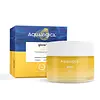What's inside
What's inside
 Key Ingredients
Key Ingredients

 Benefits
Benefits

 Concerns
Concerns

No concerns
 Ingredients Side-by-side
Ingredients Side-by-side

Water
Skin ConditioningDimethicone
EmollientGlycerin
HumectantButylene Glycol
HumectantAmmonium Acryloyldimethyltaurate/Vp Copolymer
Ethylhexylglycerin
Skin ConditioningPhenoxyethanol
PreservativeLinoleamidopropyl Pg-Dimonium Chloride Phosphate
Ammonium Acryloyldimethyltaurate Crosspolymer
Emulsion StabilisingDimethicone Crosspolymer
Emulsion StabilisingCaprylic/Capric Triglyceride
MaskingHyaluronic Acid
HumectantNiacinamide
SmoothingSodium PCA
HumectantXylitylglucoside
HumectantAnhydroxylitol
HumectantXylitol
HumectantAcrylates/Beheneth-25 Methacrylate/Hema Crosspolymer
Emulsion StabilisingAscorbic Acid
AntioxidantCarica Papaya Fruit Extract
Skin ConditioningCI 19140
Cosmetic ColorantWater, Dimethicone, Glycerin, Butylene Glycol, Ammonium Acryloyldimethyltaurate/Vp Copolymer, Ethylhexylglycerin, Phenoxyethanol, Linoleamidopropyl Pg-Dimonium Chloride Phosphate, Ammonium Acryloyldimethyltaurate Crosspolymer, Dimethicone Crosspolymer, Caprylic/Capric Triglyceride, Hyaluronic Acid, Niacinamide, Sodium PCA, Xylitylglucoside, Anhydroxylitol, Xylitol, Acrylates/Beheneth-25 Methacrylate/Hema Crosspolymer, Ascorbic Acid, Carica Papaya Fruit Extract, CI 19140
Water
Skin ConditioningCaprylic/Capric Triglyceride
MaskingCoco-Caprylate/Caprate
EmollientGlycerin
HumectantGlyceryl Glucoside
HumectantGlyceryl Stearate
EmollientCarica Papaya Fruit Extract
Skin ConditioningBetaine
HumectantLecithin
EmollientSodium Ascorbyl Phosphate
AntioxidantPentaerythrityl Distearate
EmulsifyingBehenyl Alcohol
EmollientSodium Hyaluronate Crosspolymer
HumectantPentylene Glycol
Skin ConditioningCarbomer
Emulsion StabilisingSodium Acrylates Copolymer
Trisodium Ethylenediamine Disuccinate
Iron Oxides
Ethylhexylglycerin
Skin ConditioningSodium Hydroxide
BufferingPhenoxyethanol
PreservativeParfum
MaskingWater, Caprylic/Capric Triglyceride, Coco-Caprylate/Caprate, Glycerin, Glyceryl Glucoside, Glyceryl Stearate, Carica Papaya Fruit Extract, Betaine, Lecithin, Sodium Ascorbyl Phosphate, Pentaerythrityl Distearate, Behenyl Alcohol, Sodium Hyaluronate Crosspolymer, Pentylene Glycol, Carbomer, Sodium Acrylates Copolymer, Trisodium Ethylenediamine Disuccinate, Iron Oxides, Ethylhexylglycerin, Sodium Hydroxide, Phenoxyethanol, Parfum
Ingredients Explained
These ingredients are found in both products.
Ingredients higher up in an ingredient list are typically present in a larger amount.
This ingredient is an emollient, solvent, and texture enhancer. It is considered a skin-softener by helping the skin prevent moisture loss.
It helps thicken a product's formula and makes it easier to spread by dissolving clumping compounds.
Caprylic Triglyceride is made by combining glycerin with coconut oil, forming a clear liquid.
While there is an assumption Caprylic Triglyceride can clog pores due to it being derived from coconut oil, there is no research supporting this.
Learn more about Caprylic/Capric TriglycerideCarica Papaya Fruit Extract comes from the papaya fruit. Papayas were first domesticated in Mexico and Central America.
This fruit extract contains papain and chymopapain, two types of enzymes. These enzyme have exfoliating and anti-inflammatory properties. One study shows papain may help reduce scarring.
Papaya is also a rich source of antioxidants. Antioxidants protect your skin against damage from free-radical molecules. This may help protect against signs of aging. One antioxidant present in papayas is lycopene.
Papaya also contains Vitamin A, also known as retinol.
While papaya is used as an ingredient to help lighten skin, research is limited on this.
The seeds of papaya have been found to have anti-fungal activity.
Learn more about Carica Papaya Fruit ExtractEthylhexylglycerin (we can't pronounce this either) is commonly used as a preservative and skin softener. It is derived from glyceryl.
You might see Ethylhexylglycerin often paired with other preservatives such as phenoxyethanol. Ethylhexylglycerin has been found to increase the effectiveness of these other preservatives.
Glycerin is already naturally found in your skin. It helps moisturize and protect your skin.
A study from 2016 found glycerin to be more effective as a humectant than AHAs and hyaluronic acid.
As a humectant, it helps the skin stay hydrated by pulling moisture to your skin. The low molecular weight of glycerin allows it to pull moisture into the deeper layers of your skin.
Hydrated skin improves your skin barrier; Your skin barrier helps protect against irritants and bacteria.
Glycerin has also been found to have antimicrobial and antiviral properties. Due to these properties, glycerin is often used in wound and burn treatments.
In cosmetics, glycerin is usually derived from plants such as soybean or palm. However, it can also be sourced from animals, such as tallow or animal fat.
This ingredient is organic, colorless, odorless, and non-toxic.
Glycerin is the name for this ingredient in American English. British English uses Glycerol/Glycerine.
Learn more about GlycerinPhenoxyethanol is a preservative that has germicide, antimicrobial, and aromatic properties. Studies show that phenoxyethanol can prevent microbial growth. By itself, it has a scent that is similar to that of a rose.
It's often used in formulations along with Caprylyl Glycol to preserve the shelf life of products.
Water. It's the most common cosmetic ingredient of all. You'll usually see it at the top of ingredient lists, meaning that it makes up the largest part of the product.
So why is it so popular? Water most often acts as a solvent - this means that it helps dissolve other ingredients into the formulation.
You'll also recognize water as that liquid we all need to stay alive. If you see this, drink a glass of water. Stay hydrated!
Learn more about Water